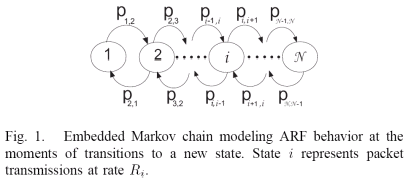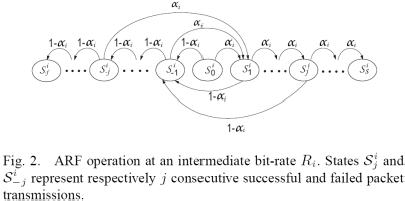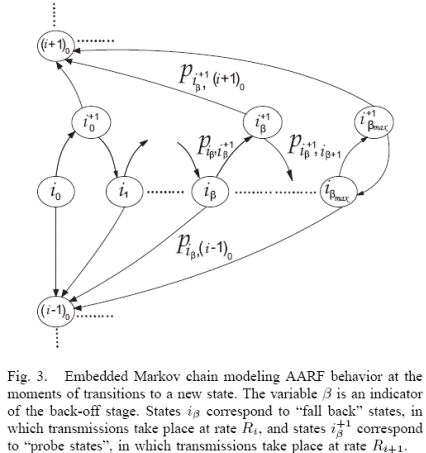Analysis of Rate-adaptation Techniques in Wireless Local Area NetworksThis work involves analytical modeling of the most widely implemented rate-adaptation algorithms deployed for throughput optimization in WLAN systems. We are developing an analytical framework to gain an insight into the performance of rate-adaptation techniques with a goal of optimizing them. Specifically we are analyzing two of the most widely implemented rate-adaptation algorithms, Auto Rate Fall-back (ARF) and Adaptive Auto Rate Fall-back (AARF), by modeling them as Semi-Markov processes. Having recognized the IEEE 802.11 WLAN to be the most widely deployed wireless system we have furthered the relevance of our analysis by capturing the protocol specific MAC mechanisms which impact the performance of rate-adaptation algorithms. Our model takes into account the physical and virtual channel sensing techniques as specified in the IEEE 802.11 standard utilized for collision avoidance. We also model the binary exponential back-off procedure which is used as the primary collision resolution mechanism. Hence under the statistical assumption made by us in order to keep the developed analysis traceable we precisely model the dynamics of evolution of ARF and AARF in IEEE 802.11 WLAN system. OPNET plays a key role in our research. Using OPNET we simulate ARF and AARF deployed in an IEEE 802.11 network and gather relevant statistics. We then compare the simulation results with the ones obtained from the analysis. This provides us the validation we need as OPNET very closely replicates the IEEE 802.11 WLAN protocol. We use the OPNET Modeler and the wireless module to carry out the simulations. We now provide a brief overview of our analytical framework which also includes a description of ARF and AARF. For a detailed description of our work so far you can download our IEEE Secon conference paper.Auto Rate Fall-back (ARF)


Adaptive Auto Rate Fall-back (AARF)

|
|
Photonics Building, Room 413
8 St Mary's Street,
Boston MA 02215
Initial web site created by Sachin Agarwal (ska@alum.bu.edu), Modified by Weiyao Xiao (weiyao@alum.bu.edu), Moved to TWiki backend by Ari Trachtenberg (trachten@bu.edu). Managed by Jiaxi Jin (jin@bu.edu).
